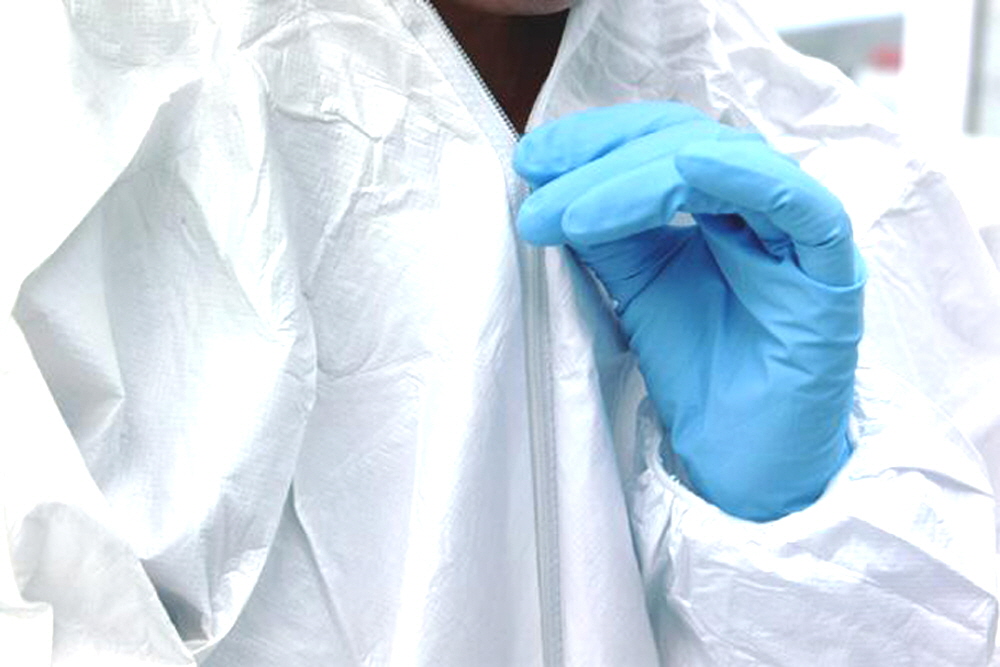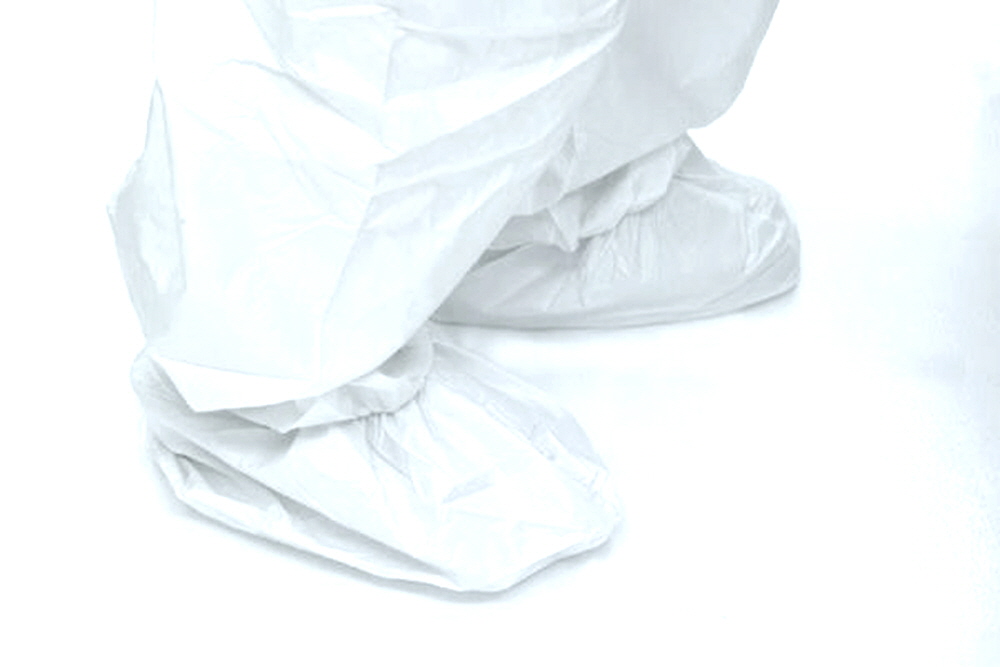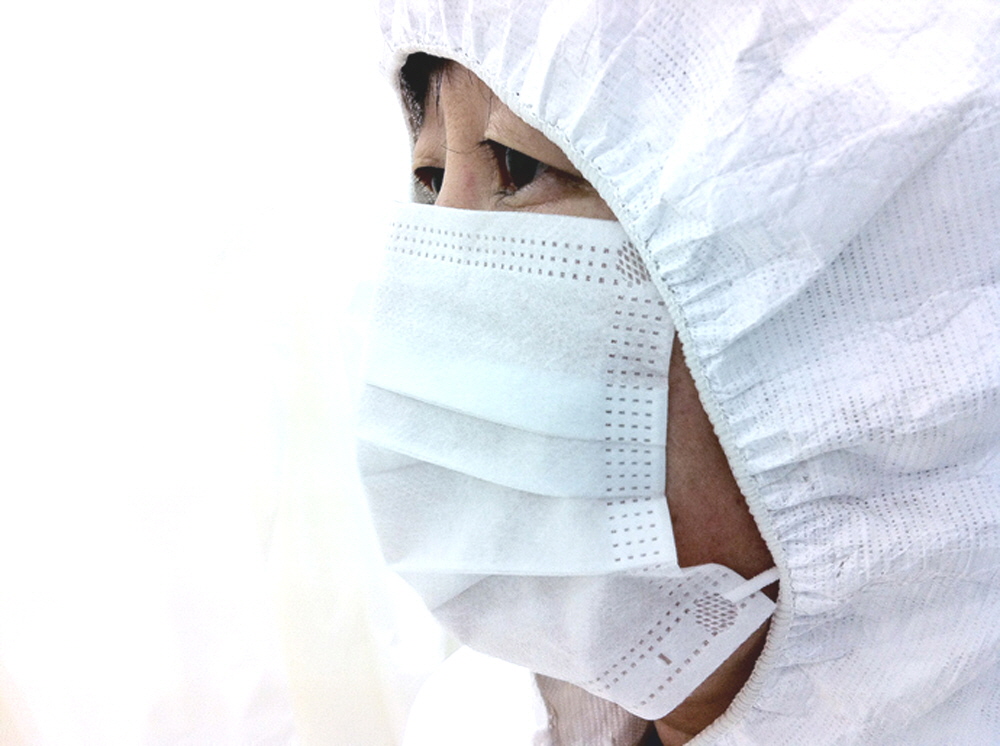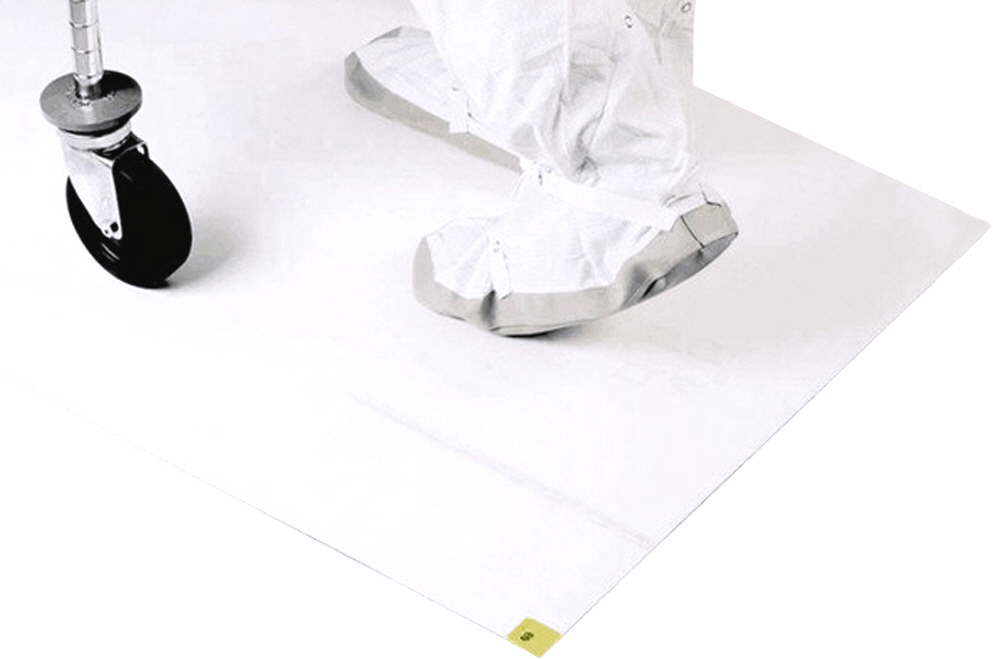Cleanroom Suits
Data Sheet
![]() Shop this product in our online store
Shop this product in our online store
Synthetic, high-performance microarray cleanroom suits, hoods, face masks and adhesive “sticky” mats offering superior protection for the most stringent cleanroom environments. Our proprietary aerospace fabrics and materials prevent particle contamination while providing user convenience and comfort. Highly recommended for all microarray manufacturing facilities as well as cleanrooms for research, life sciences, diagnostics, healthcare and semi-conductor applications.
Products - Microarray Cleanrooms - Cleanroom Suits, Hoods, Face Masks and Adhesive “Sticky” Floor Mats

Arrayit synthetic, high-performance microarray cleanroom suits offer superior protection and user comfort for the most stringent cleanroom environments. Suits include elastic hood, wrist and ankle bands, attached hood and booties, front zipper and breathability. Highly recommended for class 1, 10, 100, 1,000 and 10,000 cleanroom environments for research, life sciences, diagnostics, healthcare and semi-conductor applications. We also offer premium adhesive “sticky” floor mats and disposable hoods and face masks.
Table of Contents
- Introduction
- Quality Control
- Product Description
- Technical Notes
- Technical Assistance
- Short Protocol
- Complete Protocol
- Recommended Equipment
- Troubleshooting Tips
- Ordering Information
- Warranty
Introduction
Congratulations on taking a big step towards improving the economies of scale, quality and speed of your microarray cleanroom research. This booklet contains a complete set of illustrations and protocols outlining the steps and principles needed to use ArrayIt® Microarray Cleanroom Suits (MCSS, MCSM, and MCSL, and MCSXL).
Quality Control
Arrayit assures the performance of this product. The finest scientific research went into the development of this product. Rigorous quality control monitoring on a lot-by-lot basis guarantees that these cleanroom suits conform to the highest cleanroom industry standards.
Product Description
Arrayit's Microarray Cleanroom Suits (MCSS, MCSM, and MCSL, and MCSXL) provide the highest quality synthetic, high-performance cleanroom suits at an affordable price. All of our cleanroom suits are manufactured in state-of-the art class 10 cleanrooms. Cleanroom manufacturing eliminates contamination of the suits with particulates, fibers, proteases, nucleases and other contaminants that impair the quality of microarray experimentation if non-cleanroom suits are used. Compare our cleanroom suits with traditional laboratory coats and gowns and you will see the difference.
Users will appreciate the following features of Microarray Cleanroom Suits (MCSS, MCSM, and MCSL, and MCSXL):
- Manufactured in state-of-the-art class 10 cleanrooms
- Free of particulates, fibers and biological contaminants
- Ultra-low emission of volatile organics
- Four sizes (small, medium, large, and extra large) to fit all cleanroom personnel
- Convenient single suit per package
- 100% high-tech synthetic composition
- 99.9% retention of dry particles 0.2 µm and larger
- Resistance to light chemical splashes
- Certified by the American Society for Testing and Materials (ASTM)
- Zippered front for easy donning and changing
- Attached hood and boots for the ultimate in cleanroom protection
- Elastic wrist and ankle bands provide snug fit
- Use for a wide variety of cleanroom manufacturing needs
- Compatible with all microarray cleanroom environments
- Vast improvement over traditional laboratory coats and cleanroom gowns
- Based on years of intensive microarray cleanroom R&D
- Durable and chemically-resistant fabric
- No tearing with normal use, and highly affordable
- Anti-static packaging eliminates electrostatic contamination
- Can also be used in traditional, non-cleanroom laboratories
- Disposable
- Three year shelf life at room temperature
Technical Notes
Federal Cleanroom Standard 209E defines and evaluates cleanrooms based on the number of particles of 0.5 µm diameter or larger present per cubic foot of cleanroom air, and those same standards are used to benchmark Arrayit’s microarray cleanrooms and cleanroom products. Class 1, 10, 100, 1,000 and 10,000 cleanrooms contain fewer than 1, 10, 100, 1,000 and 10,000 particles/ft3, respectively. ArrayIt® Microarray Cleanroom Suits (MCSS, MCSM, and MCSL, and MCSXL) are manufactured in class 10 cleanrooms. The ambient air in a traditional research laboratory contains up to 1,000,000 particles/ft3 depending upon the facility.
ArrayIt® Microarray Cleanroom Suits (MCSS, MCSM, and MCSL, and MCSXL) are sized in accordance with standard laboratory clothing. Small, medium, large, and extra large sizes fit persons possessing but not exceeding the following height and body weight: small fits up to 5’ 2” (157 cm) and 110 lbs (50 kg), medium fits up to 5’ 6” (168 cm) and 145 lbs (66 kg), large fits up to 5’ 10” (178 cm) and 180 lbs (82 kg), and extra large fits up to 6’ 2” (188 cm) and 220 lbs (100 kg).

Figure 1. Microarray Cleanroom Suit (MCSS) with zippered front. Shown is a cleanroom researcher zippering the front of a small Microarray Cleanroom Suit (MCSS) in the changing room of a class 1 microarray cleanroom. The one-piece design with zipper allows easy donning and changing.
Technical Assistance
Please contact us if you have any comments, suggestions, or if you need technical assistance. By electronic mail: arrayit@arrayit.com (under the subject heading, please type, “Technical assistance”).

Figure 2. Microarray Cleanroom Suit (MCSS) in microarray cleanroom. Shown is a Microarray Cleanroom Suit, size small, being worn by a cleanroom researcher. Note the attached hood and boots for convenience and enhanced protection.
Short Protocol (Steps 1-6):
1. Remove the Microarray Cleanroom Suits from the shipping box.
2. Decontaminate the anti-static bag topically with 100% ethanol.
3. Decontaminate the anti-static bag with particle-free forced air (optional).
4. Transport the Microarray Cleanroom Suits into the cleanroom vestibule.
5. Remove excess clothing and don the Microarray Cleanroom Suit.
6. Enter the cleanroom and perform cleanroom tasks as needed.

Figure 3. Microarray Cleanroom Suit (MCSS) with elastic wristbands. Shown is a cleanroom researcher with gloved hands using a cleanroom “squeeze bottle”. Note the elastic wristbands of the Microarray Cleanroom Suit for enhanced protection against cleanroom contamination.
Complete Protocol (Steps 1-6):
1. Remove the Microarray Cleanroom Suits from the shipping box. The packaging material is a silver-colored anti-static bag that prevents electrostatic and particle contamination of the suits. Do not open the anti-static bag until inside the vestibule or changing room of a cleanroom.
2. Decontaminate the anti-static bag topically with 100% ethanol. Cover your hands with Microarray Cleanroom Gloves, wet a cleanroom wipe liberally with 100% ethanol, and wipe the outside of the silver anti-static package to remove particulates and other forms of debris. Do not open zip-lock package until inside the cleanroom vestibule or changing room.
3. Decontaminate the anti-static bag with particle-free forced air (optional). For Class 1, 10, 100 and 1,000 cleanrooms, the anti-static package should also be decontaminated with a filtered source of pressurized oil-free air prior to entry into the cleanroom vestibule or changing room. Forced air removes additional contaminating particles prior to entering the cleanroom facility. Make certain to wear Microarray Cleanroom Gloves at all times when handling the decontaminated, anti-static packaging material. Failure to wear suitable hand protection will introduce hand oils, ribonucleases, and other contaminants into the cleanroom.
4. Transport the Microarray Cleanroom Suits into the cleanroom vestibule or changing area. Make certain to remove shoes, sweaters, and other non-essential clothing prior to entering the cleanroom. Microarray Cleanroom Gloves or equivalent hand coverings should also be worn at all times when inside a cleanroom. Open the zip-lock package and remove the cleanroom suit. Unfold it carefully into its fully extended form.
5. Remove excess clothing and don the Microarray Cleanroom Suit. Open the zipper completely prior to donning and step into the Microarray Cleanroom Suit, making sure that the appropriate suit size (S, M, L, and XL) has been selected. Close the cleanroom suit by zippering the front completely, and make certain that the elastic wrist and ankle bands are positioned properly. The cleanroom suit should fit snuggly, but should allow free movement. Cleanroom suits that are too large or too small should not be worn in a cleanroom, and the correct size suit should be used at all times. Personnel with long hair should make sure that all hair is tucked inside the elastic hood of the cleanroom suit. Face shields and other respiratory devices can also be worn to provide additional containment against contamination. Gloved hands should be decontaminated topically with ethanol using Microarray Cleanroom Wipes prior to entering the cleanroom.
6. Enter the cleanroom and perform cleanroom tasks as needed. Microarray Cleanroom Suits provide excellent protection against cleanroom contamination by the human body, which can emit up to 1,000,000 particles per hour if not properly covered. Personnel should avoid excessive or extreme movements to prevent tearing the cleanroom suit. If the cleanroom suit is torn during use, exit the cleanroom immediately and don a new suit. The use of torn or damaged cleanroom suits in a cleanroom is strictly forbidden. Personnel should replace their cleanroom suits every 20 hours of use as part of good cleanroom procedure. The use of soiled cleanroom suits is not recommended under any circumstances. Microarray Cleanroom Suits are disposable and soiled suits can be discarded in the cleanroom waste containers located in the changing room or vestibule. Cleanroom suit material should never be exposed to flammable substances or sources of open flame.
Recommended Equipment
Microarray Cleanroom Wipes
Microarray Cleanroom Gloves
Stealth Micro Spotting Device
SpotBot® 2 Personal Microarrayer
Super Microarray Substrates
High Throughput Wash Station
Microarray High-Speed Centrifuge
Microarray Hybridization Cassette

Figure 4. Microarray Cleanroom Suit (MCSS) with attached boots. Shown is a cleanroom researcher donning a cleanroom suit with attached boots. Note the elastic ankle bands of the Microarray Cleanroom Suit for enhanced comfort and ease-of-use.

Figure 5. Microarray Cleanroom Masks (MCFM) to trap particulates and other contaminants generated by clean room staff during cleanroom operation, with ear loops, three-ply pleated design and 0.05 µm filtration at >99% efficiency in soft, non-woven polypropylene with full-length aluminum bridge.

Figure 6. Microarray Cleanroom Hoods (Cat. MCH) to trap particulates and other contaminants generated by clean room staff during cleanroom operation, with elastic face band and one-piece head and shoulder covering for optimal convenience, comfort and performance in a disposable cleanroom hood.

Figure 7. Microarray Cleanroom Adhesive Floor “Sticky” Mats (Cat. MCSK) to trap particulates and other contaminants generated by foot traffic, cleanroom carts, and other sources, 18 x 36” (46 x 90 cm), 30 adhesive sheets per mat.
Troubleshooting Tips
Occasional cleanroom suit tearing:
- Choose a larger size or avoid excessive or extreme movements.
Cleanroom suit uncomfortably warm:
- Untitled Document
- Reduce the temperature in the cleanroom and remove excess clothing such as heavy shirts and sweaters.

